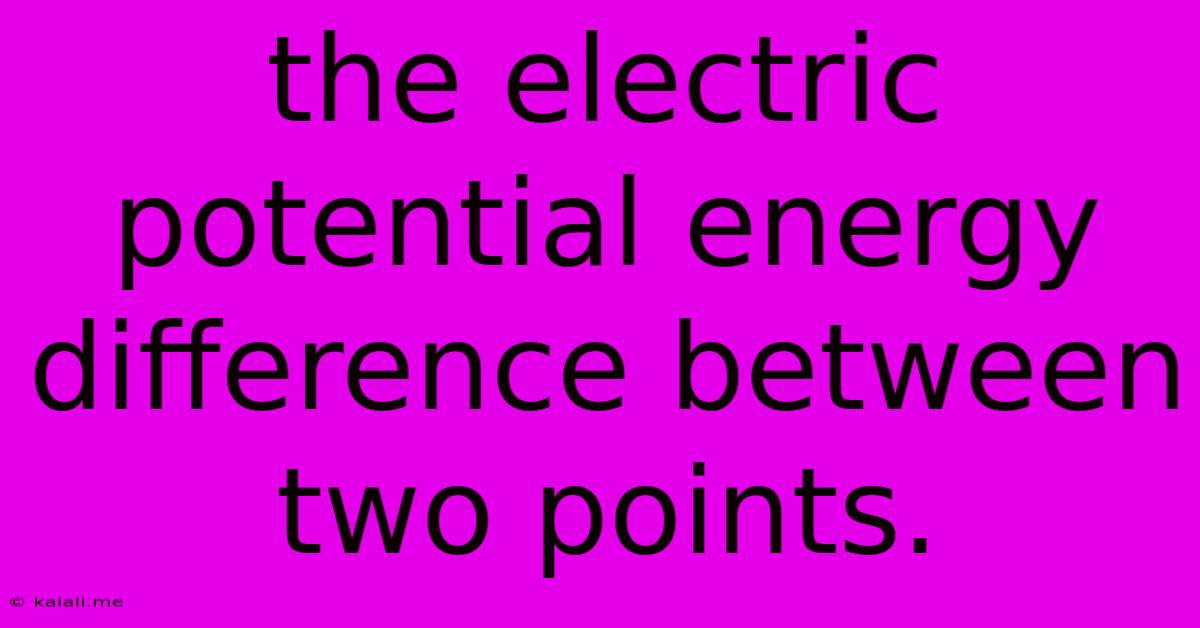The Electric Potential Energy Difference Between Two Points.
Kalali
Jun 08, 2025 · 3 min read

Table of Contents
Understanding the Electric Potential Energy Difference Between Two Points
Meta Description: Learn about electric potential energy difference, its calculation using electric fields and potential, and its crucial role in understanding circuits and electric phenomena. We'll explore the concept in detail with clear explanations and examples.
Electric potential energy difference, also known as potential difference or voltage, is a fundamental concept in electrostatics and circuits. It represents the work required to move a unit positive charge between two points in an electric field. Understanding this difference is crucial for grasping how electric circuits function and various electrical phenomena.
What is Electric Potential Energy?
Before diving into the difference, let's define electric potential energy. Imagine a positive charge placed within an electric field created by another charge. The field exerts a force on the charge, and this force can do work. The electric potential energy (U) is the energy a charge possesses due to its position within the electric field. It's analogous to gravitational potential energy – an object higher up has more potential energy than one lower down. A positive charge placed closer to a positive source charge has higher potential energy than one farther away.
Calculating Electric Potential Energy Difference
The electric potential energy difference (ΔU) between two points A and B is the difference in electric potential energy between those two points. It's calculated as the work (W) done by an external force to move a charge (q) from point A to point B against the electric field. Mathematically:
ΔU = U<sub>B</sub> - U<sub>A</sub> = W
This work is also related to the electric potential (V) at points A and B:
ΔU = q(V<sub>B</sub> - V<sub>A</sub>) = qΔV
Here:
- ΔU: Electric potential energy difference (Joules)
- U<sub>A</sub> & U<sub>B</sub>: Electric potential energy at points A and B (Joules)
- W: Work done (Joules)
- q: Charge (Coulombs)
- V<sub>A</sub> & V<sub>B</sub>: Electric potential at points A and B (Volts)
- ΔV: Potential difference or voltage (Volts)
The potential difference (ΔV) is often simply referred to as voltage and is measured in volts. One volt is equal to one joule per coulomb (1 V = 1 J/C).
Electric Field and Potential Difference
The electric field (E) and the potential difference are intimately related. The electric field strength is the negative gradient of the electric potential:
E = -∇V
This means that the electric field points in the direction of the greatest decrease in electric potential. In simpler terms, charges tend to move from regions of high potential to regions of low potential.
Examples of Electric Potential Energy Difference
- Batteries: A battery maintains a potential difference between its terminals. This difference drives the flow of electrons through a circuit.
- Capacitors: Capacitors store energy by accumulating charge, creating a potential difference between their plates.
- Power Outlets: Household power outlets provide a potential difference of typically 120V (in North America) or 230V (in many other parts of the world). This potential difference powers our appliances.
Understanding the Significance
The electric potential energy difference is crucial in many areas, including:
- Circuit Analysis: Understanding voltage drops across components is fundamental to analyzing and designing circuits.
- Electromagnetism: The concept is essential for understanding phenomena like electromagnetic induction and the behavior of charged particles in electric and magnetic fields.
- Electronics: Voltage differences drive the operation of transistors, integrated circuits, and other electronic components.
In conclusion, understanding the electric potential energy difference is fundamental to understanding how electricity works. By grasping its calculation and relationship to electric fields and potential, you can gain a deeper insight into the world of electromagnetism and its applications.
Latest Posts
Latest Posts
-
How To Block Instagram On Mac Using Terminal
Jun 08, 2025
-
The Very Elect Will Be Deceived
Jun 08, 2025
-
What Does Following A Blog Mean
Jun 08, 2025
-
How To Fix Shower Diverter In Wall
Jun 08, 2025
-
Spacex Landing Zones 1 And 2
Jun 08, 2025
Related Post
Thank you for visiting our website which covers about The Electric Potential Energy Difference Between Two Points. . We hope the information provided has been useful to you. Feel free to contact us if you have any questions or need further assistance. See you next time and don't miss to bookmark.